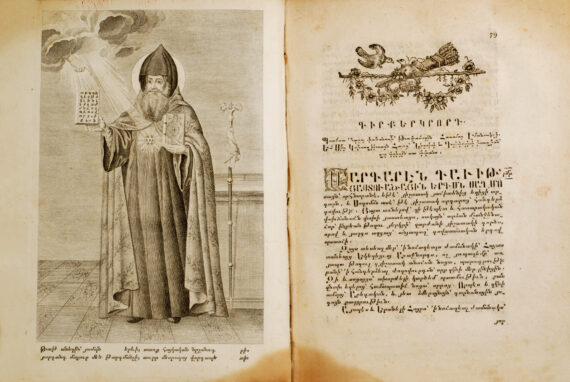ENCYCLIQUE
Printed, 1788. St. Petersburg
ENCYCLIQUE
Printed, 1788. St. Petersburg
H 170mm / W 230mm
Left Page. Engraving representing the Catholicos Saint Nerses Chnorhali dressed in his liturgical vestments blessing with the right hand and holding with the left hand the priestly cane surmounted by the tau with opposite snakes, emblem of the doctors of theology (Vartabed). In the left corner, a cherub presents him with the book, and on the opposite side the dove of the Holy Spirit illuminates the Catholicos.
On the right page, the text begins with: “Nerses servant of Christ and with the mercy of the very same, Catholicos of Armenia.
Owing to the sacred value attributed by the Armenian people to the handwritten book, the printed book did not supersede it until the 19th century, almost three hundred years after the first publication of a book which came off the press in Venice in 1511. In its early days the printed book was, unlike manuscripts, exclusively the work of the diaspora. It was in Europe that the first works were published, initially in Venice and later in Amsterdam, where the first Bible was printed in 1666. The texts published in the 16th and 17th centuries were sometimes of religious, sometimes historical, and sometimes scholarly nature.
In the 18th century, Venice underwent a revival thanks to the considerable work of Abbot Mekhitar of Sebaste. The typography workshop on the island of San Lorenzo, opposite Venice, published a number of classical Armenian works, as well as translations of European literary works for use by students, historical and philological studies, and the 1837 dictionary, which is still the authoritative reference today.
It was only in the 19th century, however, that printing really took off with the secularization of culture which, until then, had been disseminated under the quasi-monopoly of the Church.
The replacement of the classical language by modern Armenian and the development of the press completed this evolution.
This heralded the birth of modern literature.
The printed book is no longer just an edition of the manuscript.
It now became an instrument of modern thought.
Mesrop Mashtots was the inventor of the Armenian alphabet in the early 5th century AD.
The ""Mashtots” is named after him; it is a work that contains all the biblical readings, texts, hymns, and practical instructions required for the celebration of the sacraments, baptisms, weddings, funerals, and others, and for special circumstances, such as the blessing of the sick, prayers against drought, for the harvest, etc.



